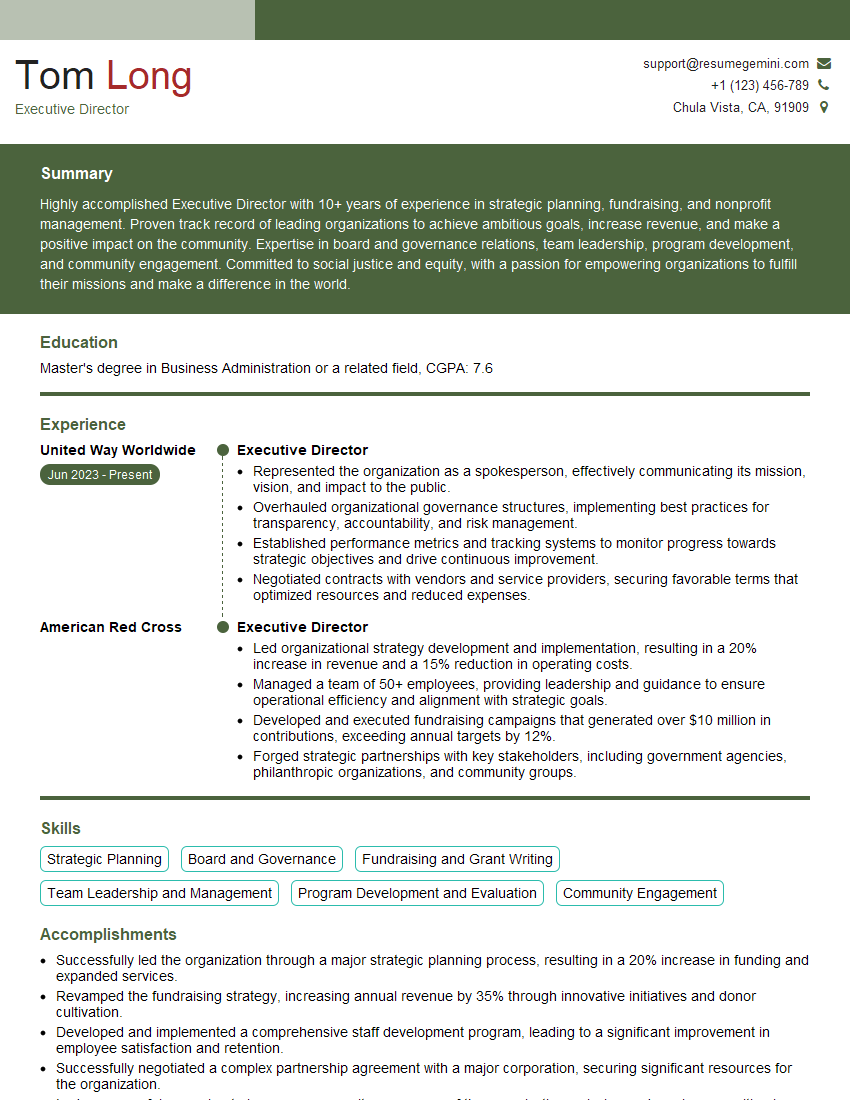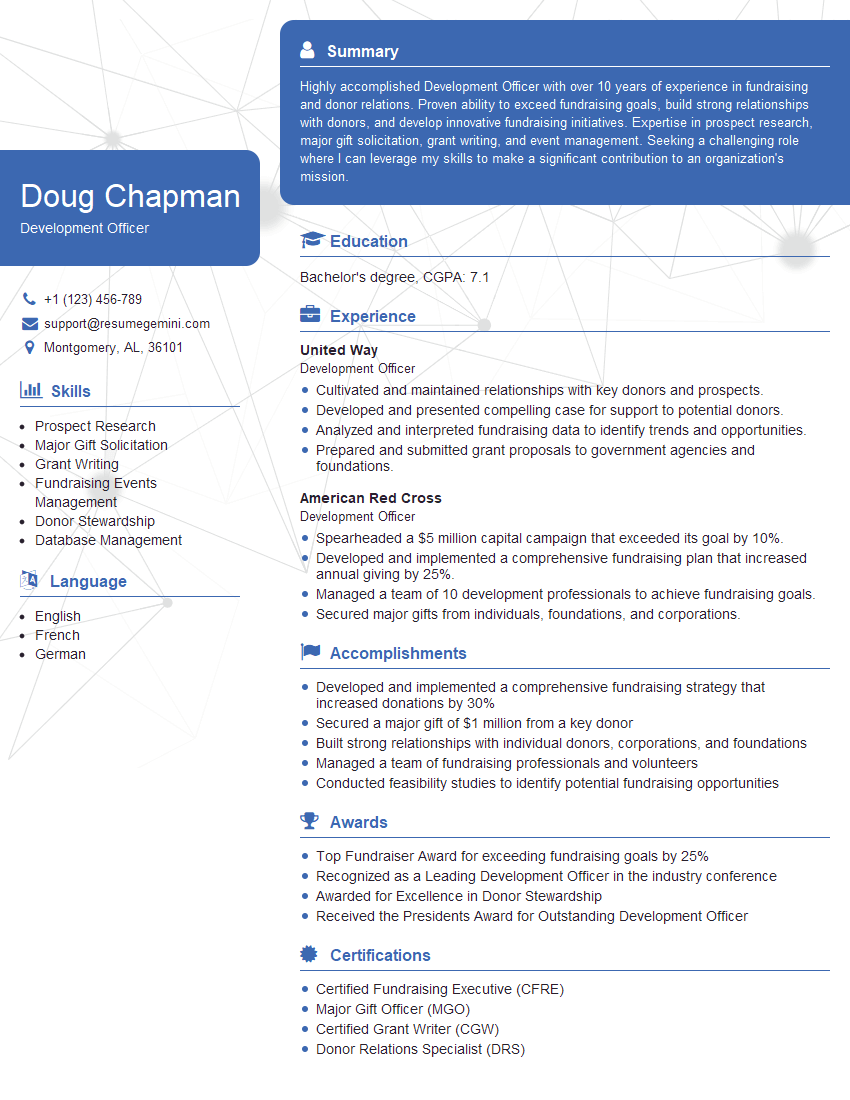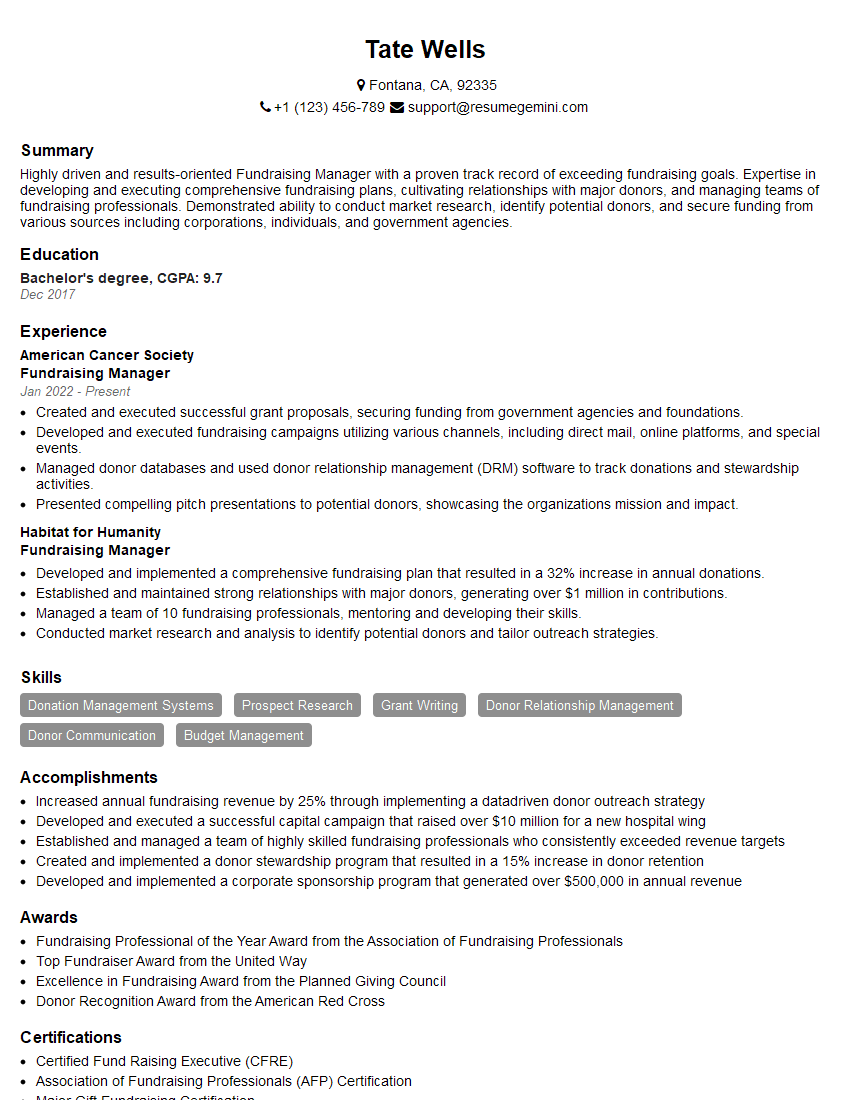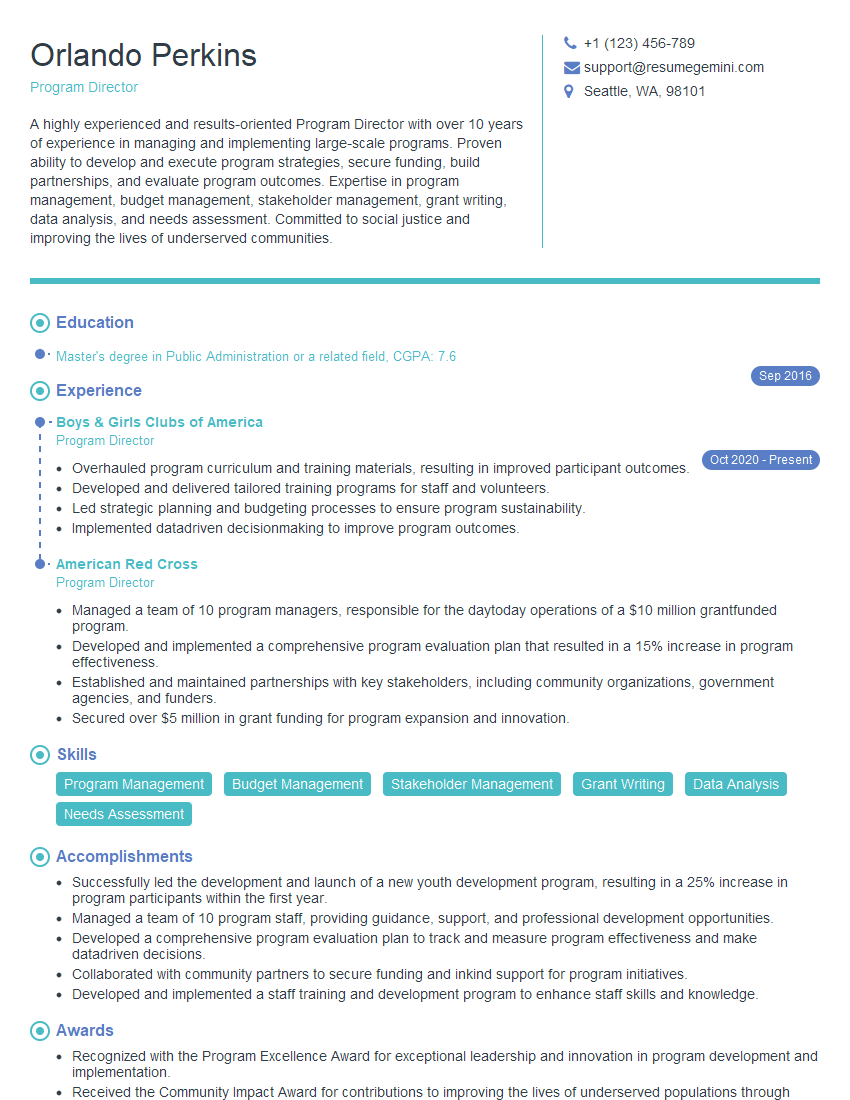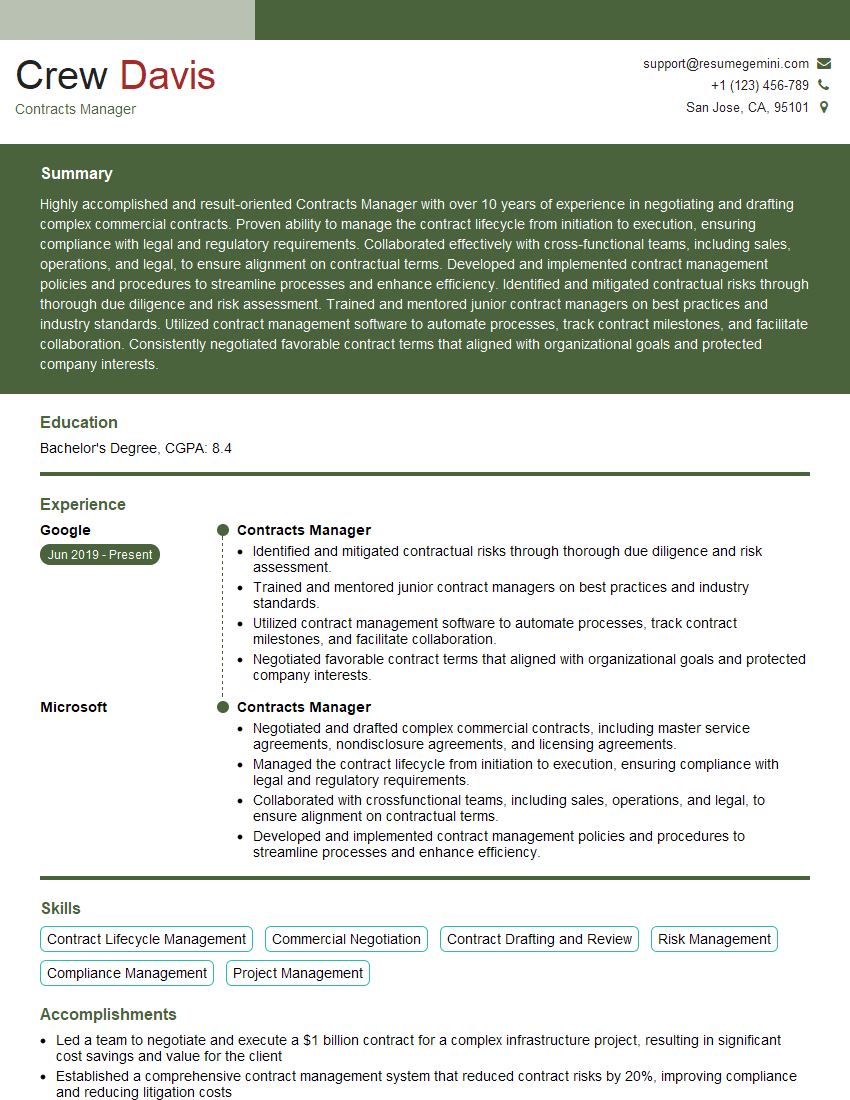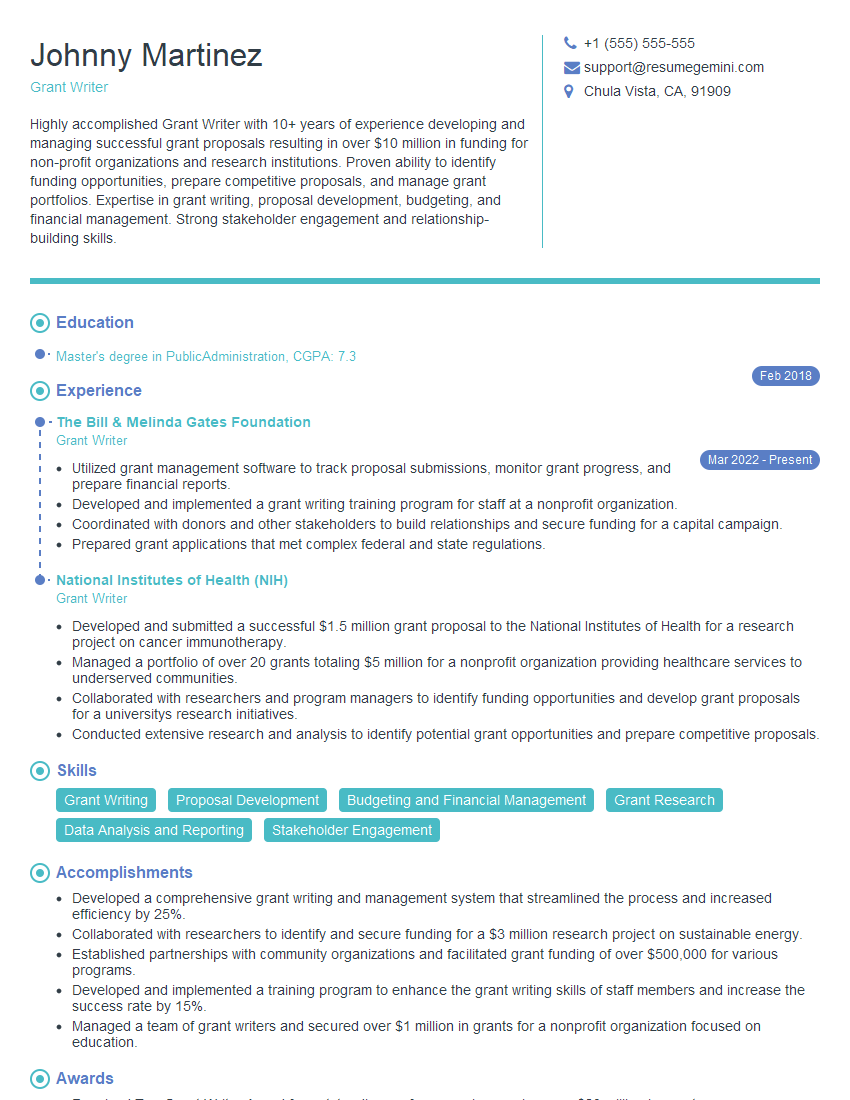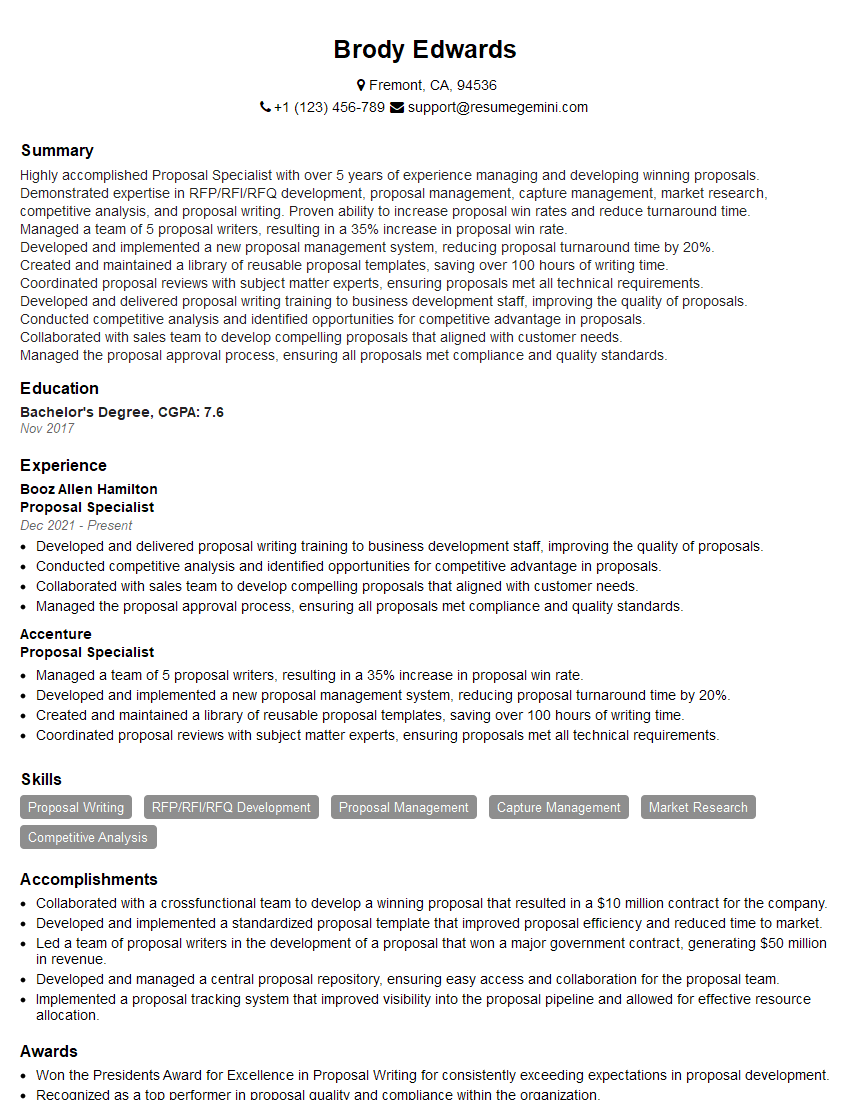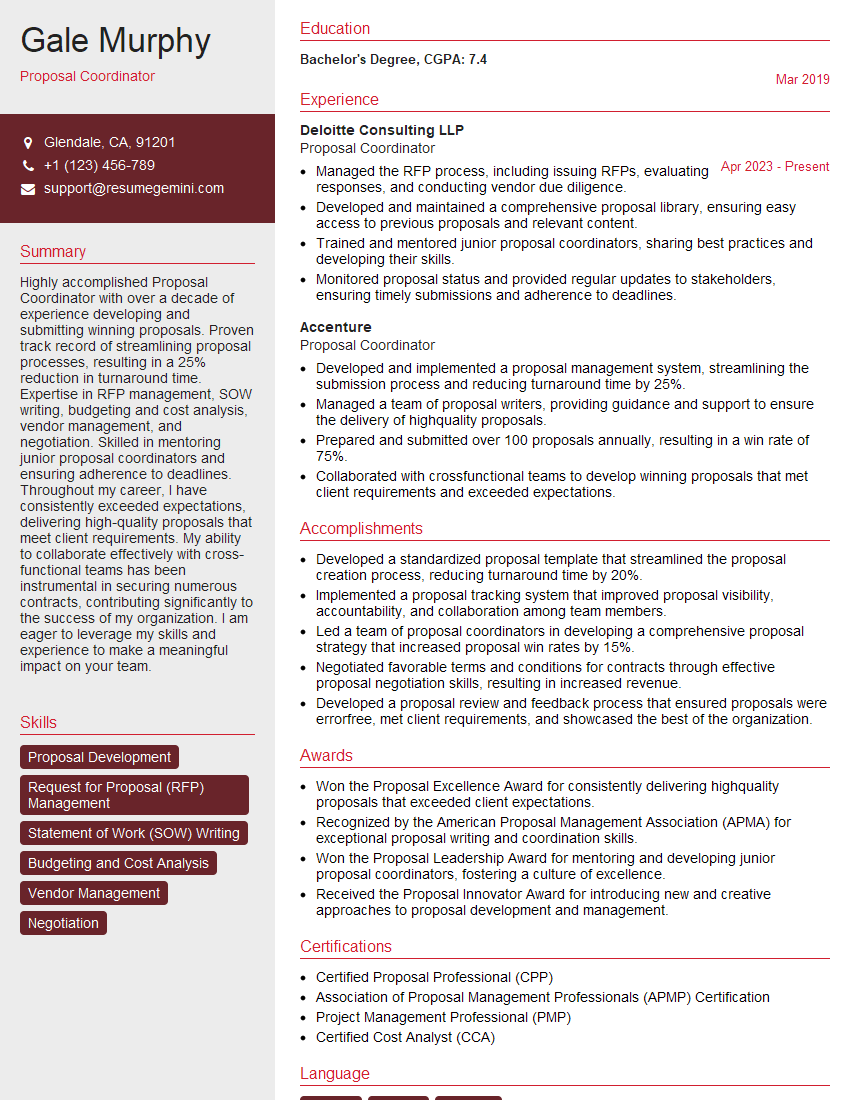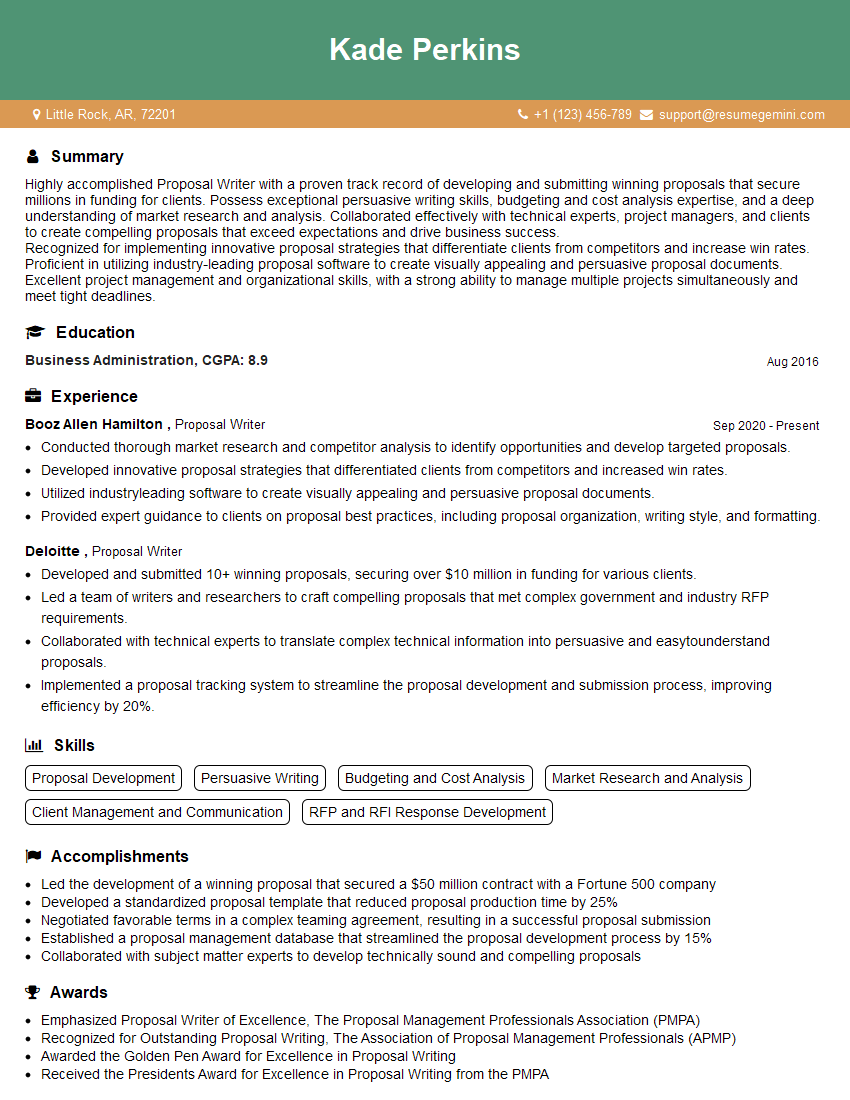Unlock your full potential by mastering the most common Knowledge of current trends in program proposals interview questions. This blog offers a deep dive into the critical topics, ensuring you’re not only prepared to answer but to excel. With these insights, you’ll approach your interview with clarity and confidence.
Questions Asked in Knowledge of current trends in program proposals Interview
Q 1. Describe your experience with current trends in program proposal writing.
Current trends in program proposal writing emphasize a strong focus on data-driven narratives, clear articulation of impact, and a collaborative approach to proposal development. Funders are increasingly looking for proposals that demonstrate a deep understanding of the problem being addressed, a well-defined methodology for achieving results, and a robust plan for evaluation and sustainability. There’s a shift away from lengthy, jargon-filled proposals towards concise, compelling documents that clearly communicate value and demonstrate a commitment to transparency and accountability. For example, the use of logic models is becoming increasingly standard, providing a visual representation of the program’s theory of change. Another trend is the incorporation of participatory approaches, involving beneficiaries in the proposal development process. This allows for a more authentic reflection of community needs and fosters a sense of ownership.
Q 2. What are some common mistakes in program proposals and how to avoid them?
Common mistakes in program proposals include: unclear problem statements (failing to clearly define the issue being addressed), weak methodologies (lack of detail or insufficient rationale for chosen approaches), overly ambitious goals (unrealistic targets that cannot be achieved within the proposed timeframe and budget), inadequate budget justification (lack of clarity on how funds will be used), and poor writing and editing (grammatical errors, inconsistent formatting, and unclear language). To avoid these, thoroughly research the problem and target audience, develop a clear and concise logic model, set achievable goals and objectives with specific metrics, meticulously justify every budget item, and rigorously proofread the final document. Think of it like building a house: a solid foundation (clear problem statement), well-defined blueprints (methodology), and a realistic budget are crucial for success.
Q 3. How do you stay up-to-date on current trends in proposal writing?
Staying updated involves actively engaging with relevant resources. I regularly read industry publications like the GrantSpace newsletter and journals focusing on program evaluation and nonprofit management. I attend webinars and conferences on proposal writing and grantseeking, which provide opportunities to network and learn from experts. I also actively monitor the websites of major funding organizations to understand their priorities and preferences. Following key influencers on social media (LinkedIn, Twitter) involved in the field offers insights into current trends and best practices. This multi-faceted approach ensures I remain abreast of the ever-evolving landscape of proposal writing.
Q 4. What software or tools do you use to manage and create program proposals?
For proposal management and creation, I utilize a combination of tools. For writing and collaboration, I rely on Microsoft Word and Google Docs, leveraging their version control and collaborative features. For budgeting, I use spreadsheets (Excel or Google Sheets) and specialized grant writing software which helps automate some aspects of proposal formatting and tracking. Project management tools like Asana or Trello are essential for managing tasks, deadlines, and team communication during the proposal development process. Finally, I leverage citation management software like Zotero to accurately cite sources and avoid plagiarism. The choice of tools depends on the complexity of the proposal and the size of the team.
Q 5. Explain your process for developing a compelling narrative in a program proposal.
Developing a compelling narrative starts with understanding the audience (the funder). I begin by crafting a clear and concise problem statement that resonates emotionally and intellectually. I then present a compelling solution, emphasizing the innovation and impact of the proposed program. I use data and evidence to support claims and weave in compelling stories to make the proposal relatable and memorable. This narrative arc typically includes: a compelling introduction highlighting the problem’s significance, a clearly articulated solution that is feasible and sustainable, a detailed description of the methodology with a clear rationale, a robust evaluation plan showing how the impact will be measured, and a strong conclusion that summarizes the key benefits and reinforces the program’s value proposition. It’s about painting a picture, not just presenting data.
Q 6. How do you tailor a program proposal to a specific funding organization?
Tailoring a proposal involves meticulous research of the specific funding organization’s priorities, guidelines, and past awards. I analyze their mission, strategic goals, and previous funding decisions to understand their preferences. This allows me to align the proposal’s language, focus, and approach with their specific interests. For example, if an organization prioritizes environmental sustainability, I would highlight the environmental benefits of the proposed program. If they emphasize community engagement, I would showcase the participatory elements of the program. This customization increases the chances of securing funding by demonstrating that the proposal directly addresses the funder’s concerns and aligns with their overarching goals. It’s about speaking their language and demonstrating a deep understanding of their values.
Q 7. How do you assess the feasibility of a proposed program?
Assessing feasibility involves a multi-faceted approach. First, I evaluate the program’s technical feasibility – whether the proposed methods and technologies are realistic and achievable given available resources and expertise. Next, I assess economic feasibility – whether the program is financially sustainable and cost-effective. This includes examining the budget, considering potential funding sources beyond the grant, and assessing the program’s potential for long-term financial stability. Finally, I consider operational feasibility – whether the program can be implemented effectively, given logistical constraints, staffing capacity, and potential partnerships. This involves analyzing timelines, logistical challenges, and potential risks, and developing mitigation strategies to address potential problems. A thorough feasibility assessment ensures that the program is not just conceptually sound but also practically achievable.
Q 8. What metrics do you use to evaluate the success of a program proposal?
Evaluating the success of a program proposal goes beyond simply securing funding. It involves a multi-faceted approach using both quantitative and qualitative metrics. Success hinges on achieving the program’s stated objectives and demonstrating its impact.
- Quantitative Metrics: These are measurable outcomes like the number of participants served, the percentage increase in a specific skill, cost savings achieved, or changes in specific behaviors. For example, if a proposal aims to increase literacy rates among underprivileged children, a key quantitative metric would be the percentage improvement in reading scores post-program.
- Qualitative Metrics: These focus on the program’s overall impact and participant experiences. This could include feedback from surveys, interviews, testimonials, or observations on changes in attitudes, knowledge, or skills. For instance, observing increased engagement and confidence in the classroom among participating students would be a valuable qualitative metric.
- Efficiency Metrics: These assess the program’s cost-effectiveness. Examples include cost per participant served, or the ratio of program outputs to inputs.
- Sustainability Metrics: These measure the program’s long-term viability and impact after funding concludes. This could include the development of community partnerships, the establishment of self-sustaining structures, or the continued use of program outputs.
A robust evaluation plan should be incorporated into the proposal itself, outlining the specific metrics and methods used to assess success. This demonstrates a commitment to accountability and transparency.
Q 9. How do you handle budget development and justification in proposals?
Budget development and justification are critical components of a compelling proposal. A well-structured budget builds credibility and demonstrates financial responsibility.
- Detailed Breakdown: The budget should be meticulously detailed, outlining every anticipated expense with clear explanations. This includes personnel costs, materials, equipment, travel, and indirect costs.
- Justification: Each line item must be justified, explaining its necessity to achieving the program’s objectives. For example, if you’re requesting funds for specialized software, explain how it directly contributes to the program’s success and why it’s the most appropriate choice.
- Cost-Effectiveness: Highlight the program’s cost-effectiveness by showing the value for money. If possible, show comparisons to similar programs or demonstrate potential cost savings.
- Contingency Planning: Include a contingency plan to address potential cost overruns or unexpected expenses. This shows foresight and responsible financial management.
Using a standardized budget template provided by the funding agency is crucial. This ensures your proposal is formatted correctly and includes all necessary information. Always keep the budget concise, easy to understand, and aligned with the project’s overall scope and goals.
Q 10. Describe your experience with proposal collaboration and teamwork.
Successful proposal development relies heavily on effective collaboration. My experience involves working within diverse teams, leveraging each member’s expertise to produce a high-quality, cohesive proposal.
- Role Clarity: Establishing clear roles and responsibilities from the outset prevents duplication and ensures accountability. I typically facilitate these discussions and create a shared project timeline.
- Communication: Open and frequent communication is key. I utilize a variety of tools – project management software, regular meetings, email updates – to maintain transparency and address concerns promptly.
- Feedback Mechanisms: I actively solicit and incorporate feedback from team members, ensuring that all perspectives are considered. I encourage a culture of constructive criticism and iterate based on this input.
- Conflict Resolution: I’m adept at addressing disagreements constructively, finding common ground, and guiding the team towards consensus.
In a recent project focused on community health, our team – including epidemiologists, social workers, and program managers – collaboratively developed a proposal. By leveraging each member’s expertise, we created a proposal that successfully integrated multiple perspectives and had a strong foundation in both evidence-based practices and community needs.
Q 11. Explain your understanding of different proposal writing styles (e.g., narrative, logic model).
Proposal writing styles vary depending on the audience, the program’s complexity, and the funder’s preferences. However, some common styles stand out.
- Narrative Style: This style uses a compelling storytelling approach to engage the reader and showcase the program’s impact. It prioritizes clear, concise language, compelling case studies, and a human-centered focus to illustrate the problem and the proposed solution.
- Logic Model Style: This style utilizes a visual framework (the logic model) to clearly articulate the program’s theory of change. It maps out the program’s inputs, activities, outputs, outcomes, and ultimate impact. It’s particularly useful for demonstrating the causal links between program activities and desired results. This approach is often accompanied by a narrative to provide context and a compelling story.
- Results-Oriented Style: This style emphasizes the program’s measurable outcomes and achievements. It often uses data and evidence to support claims, providing strong justification for the proposed investment.
The choice of style depends on the specific context. For example, a narrative style might be more appropriate when applying for a grant focused on community development, while a logic model would be effective for a research-focused program. I’m experienced in adapting my writing style to suit the specific requirements of each proposal.
Q 12. How do you address potential risks or challenges in a program proposal?
Addressing potential risks and challenges proactively strengthens a proposal’s credibility. Ignoring them suggests a lack of foresight and planning.
- Risk Identification: Thoroughly identify potential risks, considering both internal factors (e.g., staffing shortages, unforeseen delays) and external factors (e.g., policy changes, economic downturns).
- Risk Assessment: Assess the likelihood and potential impact of each identified risk. Prioritize risks based on their severity.
- Mitigation Strategies: Develop specific strategies to mitigate identified risks. This demonstrates preparedness and reduces the chance of project failure. For example, a risk mitigation strategy for potential staff turnover could be including plans for cross-training or establishing strong mentorship programs.
- Contingency Plans: Develop contingency plans for scenarios that cannot be fully mitigated. This could involve alternative approaches or backup resources.
- Transparent Communication: Clearly communicate identified risks and mitigation strategies in the proposal. This shows transparency and responsibility.
For instance, in a proposal for a technology-based education program, a potential risk could be technology malfunctions. My approach would involve outlining this risk, assessing its impact (e.g., potential delays in program delivery), and then proposing a mitigation strategy (e.g., having backup systems, securing technical support).
Q 13. What are your preferred methods for gathering information for a program proposal?
Gathering comprehensive and reliable information is essential for a strong proposal. My approach combines multiple methods.
- Literature Review: I conduct a thorough literature review to understand the current state of knowledge and identify best practices. This includes researching relevant academic publications, policy documents, and reports.
- Data Analysis: I analyze relevant data, including statistical reports, surveys, and census data, to identify trends and inform program design.
- Stakeholder Engagement: I engage with key stakeholders – including potential beneficiaries, community leaders, subject matter experts – through interviews, focus groups, and surveys. This provides invaluable insights into needs and priorities.
- Site Visits: I conduct site visits whenever possible to gain firsthand understanding of the context.
- Expert Consultation: I consult with experts in the relevant field to validate program design and strengthen the proposal’s credibility.
For example, in preparing a proposal for a community health program, I would conduct interviews with community residents to understand their health needs, analyze existing health data to identify disparities, and consult with healthcare professionals to ensure the program’s alignment with best practices.
Q 14. Explain your experience with proposal revisions and feedback.
Proposal revisions and feedback are crucial steps in the proposal development process. My experience has shaped my approach to incorporating feedback effectively.
- Constructive Criticism: I view feedback as an opportunity for improvement, even if it’s critical. I focus on understanding the feedback’s intent and identifying areas for enhancement.
- Iterative Process: I embrace an iterative process, revising the proposal multiple times based on feedback from reviewers and colleagues.
- Clear Communication: I maintain clear communication with reviewers throughout the revision process, clarifying any points of confusion and addressing concerns proactively.
- Tracking Changes: I use version control to track changes and ensure that all feedback has been appropriately addressed.
- Documentation: I meticulously document all changes made, with justifications, and maintain a clear record of revisions.
In a recent grant application, feedback from the review panel highlighted a gap in the evaluation plan. I addressed this feedback by revising the section, incorporating more detailed metrics and a robust data collection strategy. This demonstrated responsiveness and resulted in a stronger, more competitive proposal.
Q 15. How do you manage competing deadlines and priorities in proposal development?
Managing competing deadlines and priorities in proposal development requires a structured approach. Think of it like conducting an orchestra – each instrument (task) needs to play its part at the right time to create a harmonious whole. I begin by creating a detailed project plan, breaking down the proposal into manageable tasks with clearly defined deadlines. I utilize project management tools like Gantt charts or Trello to visualize the timeline and dependencies between tasks. This allows me to identify potential conflicts early and adjust the schedule accordingly. Prioritization is crucial; I employ methods like the Eisenhower Matrix (urgent/important) to focus on the most critical tasks first. Regular progress checks and communication with team members ensure that everyone is on track and that any roadblocks are addressed promptly. For example, in a recent proposal for a large-scale community health program, I used a Gantt chart to map out the writing, review, and submission phases, ensuring that the various components, from literature review to budget justification, were completed in a timely manner.
Career Expert Tips:
- Ace those interviews! Prepare effectively by reviewing the Top 50 Most Common Interview Questions on ResumeGemini.
- Navigate your job search with confidence! Explore a wide range of Career Tips on ResumeGemini. Learn about common challenges and recommendations to overcome them.
- Craft the perfect resume! Master the Art of Resume Writing with ResumeGemini’s guide. Showcase your unique qualifications and achievements effectively.
- Don’t miss out on holiday savings! Build your dream resume with ResumeGemini’s ATS optimized templates.
Q 16. Describe your experience writing proposals for different types of funding organizations.
My experience spans various funding organizations, including government agencies (like the NIH and NSF), private foundations (e.g., Ford Foundation, Bill & Melinda Gates Foundation), and corporate sponsors. Each organization has its unique requirements and preferences in terms of proposal format, content, and evaluation criteria. For instance, government agencies often emphasize rigorous methodology and data-driven results, while private foundations may prioritize community impact and alignment with their mission. I adapt my writing style and approach to resonate with the specific funding organization. For example, a proposal for a government agency would include detailed budget justifications and a robust evaluation plan, whereas a proposal for a private foundation would highlight the program’s narrative and its potential for social impact. I tailor the language and tone to each funder’s priorities and preferred style guides.
Q 17. How do you incorporate data and evidence into program proposals?
Data and evidence are the cornerstones of a compelling program proposal. They transform a good idea into a convincing case for funding. I incorporate data and evidence throughout the proposal, starting with a thorough literature review to establish the context and demonstrate the problem’s significance. I then use data to quantify the problem, highlighting the scale and impact. For instance, if proposing a program to reduce childhood obesity, I’d include statistics on prevalence rates, health consequences, and associated costs. Next, I incorporate evidence to support the proposed intervention’s effectiveness. This might involve citing relevant research, showcasing pilot program results, or referencing successful models from similar initiatives. Finally, I detail a robust evaluation plan that outlines how the program’s impact will be measured and reported, ensuring accountability and transparency.
Q 18. What is your approach to evaluating the strengths and weaknesses of a proposal?
Evaluating a proposal’s strengths and weaknesses involves a critical and systematic approach. I use a multi-faceted evaluation framework that considers several key aspects. First, I assess the clarity and persuasiveness of the narrative – does it effectively articulate the problem, solution, and expected outcomes? Then, I examine the methodological rigor – is the proposed approach sound, feasible, and appropriate for addressing the research question or program goals? I critically review the budget, ensuring it is realistic, justified, and aligns with the proposed activities. Finally, I assess the evaluation plan to determine if it is robust enough to measure the program’s success and impact. I use a checklist and a structured scoring system to ensure objectivity and consistency in my evaluation. This process often involves seeking feedback from colleagues and experts to get a broader perspective.
Q 19. How familiar are you with government regulations related to grant proposals?
I am very familiar with government regulations related to grant proposals, particularly those related to compliance, reporting, and ethical considerations. This includes understanding requirements for cost allocation, indirect cost rates, conflict of interest disclosure, data privacy (e.g., HIPAA), and human subjects protection (e.g., IRB review). I have experience navigating complex regulations and ensuring compliance with all applicable laws and guidelines. I frequently consult resources such as the Office of Management and Budget (OMB) circulars, agency-specific guidelines, and relevant legal counsel to ensure our proposals meet all regulatory requirements. Staying updated on these regulations is crucial to ensure the proposal’s success and avoid potential penalties.
Q 20. How do you incorporate diversity, equity, and inclusion into your proposals?
Incorporating diversity, equity, and inclusion (DEI) into proposals is not just a matter of ticking boxes; it’s about designing programs that genuinely address disparities and promote equitable outcomes. I integrate DEI considerations throughout the proposal, starting with problem definition, where I explicitly acknowledge existing inequalities and their impact on the target population. I then ensure that the proposed intervention is culturally relevant and accessible to diverse groups. This might involve collaborating with community partners, using culturally appropriate language and communication strategies, and adopting participatory methods. Furthermore, the evaluation plan explicitly assesses the program’s impact across diverse subgroups, measuring both intended and unintended consequences. By actively considering DEI principles, I create proposals that are both socially responsible and more likely to achieve meaningful, lasting change.
Q 21. What are some emerging trends in program evaluation?
Emerging trends in program evaluation are moving toward greater sophistication and integration. There’s a growing emphasis on mixed-methods approaches, combining quantitative data (e.g., statistical analysis) with qualitative data (e.g., interviews, focus groups) to gain a more holistic understanding of program impact. Real-time data collection and analysis using technology, such as mobile apps and wearable sensors, are becoming increasingly common. This allows for more dynamic and responsive evaluation. The field is also increasingly adopting participatory evaluation approaches, empowering stakeholders to actively participate in the evaluation process. Finally, there is a growing focus on evaluating long-term sustainability and impact, moving beyond short-term outcomes to assess the lasting effects of programs. The emphasis is shifting from simply measuring outputs to understanding actual outcomes and the mechanisms by which the program produces these outcomes. This requires sophisticated methodologies that capture the nuances of complex social interventions.
Q 22. How do you integrate sustainability considerations into program proposals?
Integrating sustainability into program proposals isn’t just a trend; it’s a necessity. Funders increasingly prioritize projects that minimize environmental impact and promote social equity. This involves a multi-faceted approach.
- Environmental Sustainability: This focuses on reducing the carbon footprint of the program. For example, if proposing a construction project, we’d highlight the use of sustainable materials, energy-efficient designs, and waste reduction strategies. We’d quantify these impacts using metrics like reduced greenhouse gas emissions or water consumption.
- Social Sustainability: This considers the long-term societal benefits. We’d analyze the program’s impact on local communities, focusing on job creation, community engagement, and equitable access to resources. For instance, a community development program might include metrics on increased local employment or improved access to healthcare.
- Economic Sustainability: The proposal should demonstrate the program’s financial viability and long-term impact on the economy. This includes considering cost-effectiveness, job creation, and the potential for future growth and self-sufficiency. A business development program, for example, would demonstrate projected economic growth and job creation in its sustainability assessment.
By weaving these considerations throughout the proposal – from the program design to the evaluation plan – we ensure its alignment with current funding priorities and maximize the likelihood of securing funding.
Q 23. How do you manage stakeholder expectations during the proposal development process?
Managing stakeholder expectations is crucial for successful proposal development. It requires proactive communication and a clear understanding of everyone’s needs and priorities.
- Early Engagement: We start by involving key stakeholders early in the process. This includes conducting interviews and focus groups to gather input and understand their expectations.
- Regular Communication: We establish a clear communication plan with regular updates on progress. This could involve email updates, progress reports, or even dedicated stakeholder meetings.
- Realistic Expectations: We ensure that the proposal is realistic and achievable given available resources and timelines. Over-promising can lead to disappointment and damage trust.
- Feedback Mechanisms: We build in opportunities for feedback throughout the process, allowing stakeholders to provide input and make adjustments as needed. This could involve surveys, feedback forms, or informal discussions.
For example, in a recent community health initiative, we held regular meetings with local leaders, healthcare providers, and community members to gather input and address concerns, ensuring buy-in and support from all parties involved.
Q 24. How do you ensure the proposal aligns with the organization’s strategic goals?
Aligning the proposal with the organization’s strategic goals is paramount. It demonstrates a clear understanding of the organization’s mission and priorities and increases the likelihood of approval.
- Strategic Alignment Analysis: We begin by thoroughly reviewing the organization’s strategic plan, identifying key objectives, target audiences, and performance indicators.
- Mapping the Proposal: We then clearly demonstrate how the proposed program supports and advances these strategic goals. This might involve showing how the program addresses specific strategic priorities or contributes to the achievement of key performance indicators.
- Integration into Plans: We integrate the program’s objectives, activities, and evaluation metrics into the organization’s existing strategic planning frameworks.
- Resource Allocation: We demonstrate how the program aligns with the organization’s resource allocation strategies, ensuring that the proposed budget and staffing are consistent with overall resource prioritization.
Imagine a non-profit focused on youth development. If their strategic goal is to increase high school graduation rates, our program proposal for an after-school tutoring program would clearly articulate how the program directly contributes to achieving that goal, providing measurable outcomes like improved test scores and increased graduation rates.
Q 25. Describe a time when you had to adapt a program proposal based on new information.
During the development of a proposal for a rural development project, we initially focused on infrastructure improvements as the primary intervention. However, during a community consultation, we discovered that access to reliable internet was a significantly greater barrier to economic development than we’d initially anticipated.
We quickly adapted the proposal. We incorporated a significant component focused on expanding broadband access to the region, integrating this with plans for digital literacy training and the introduction of online business development resources. This pivot, based on the new information, significantly strengthened the proposal and improved its chances of success by directly addressing the community’s most pressing needs.
Q 26. How do you measure the impact of a program after it’s been funded?
Measuring program impact requires a well-defined evaluation plan developed before the program even begins. This plan needs to include clear indicators to track progress and assess success.
- Pre-determined Metrics: We establish specific, measurable, achievable, relevant, and time-bound (SMART) goals and indicators during the proposal phase. This creates a framework for post-program evaluation.
- Data Collection: We develop strategies to collect data throughout the program’s lifespan. This might involve surveys, interviews, focus groups, administrative data, or even experimental designs.
- Quantitative & Qualitative Data: We collect both quantitative data (e.g., numbers of participants, changes in test scores) and qualitative data (e.g., participant feedback, case studies) to provide a comprehensive understanding of impact.
- Independent Evaluation: Ideally, an independent evaluation team will conduct the post-program assessment to ensure objectivity and credibility.
For instance, if we’re measuring the impact of a job training program, we would track metrics such as employment rates, wage increases, and participant satisfaction, using a blend of quantitative data (employment statistics) and qualitative data (participant interviews).
Q 27. What are some key performance indicators (KPIs) you would track for a program?
The specific KPIs will vary greatly depending on the program’s goals, but some common examples include:
- Output KPIs: These measure the program’s activities and deliverables, such as the number of participants served, workshops conducted, or reports produced.
- Outcome KPIs: These measure the changes resulting from the program’s activities, such as improvements in knowledge, skills, attitudes, or behaviors.
- Impact KPIs: These measure the long-term effects of the program, such as changes in community well-being, economic growth, or environmental sustainability.
For example, a literacy program might track KPIs like the number of students participating (output), improvements in reading scores (outcome), and increased high school graduation rates (impact).
It’s important to choose KPIs that are relevant, measurable, and aligned with the program’s overarching goals.
Q 28. Describe your experience with proposal submissions and follow-up procedures.
I have extensive experience in proposal submission and follow-up. My approach is systematic and ensures that proposals are submitted on time, comply with all requirements, and are effectively followed up.
- Meticulous Preparation: I thoroughly review submission guidelines, ensuring that the proposal meets all formatting, content, and submission requirements. I also use checklist systems to track progress.
- Submission Process: I utilize secure online platforms for submission, tracking submission confirmation and deadlines.
- Post-Submission Follow-up: Following submission, I establish a plan for timely follow-up, including sending confirmation emails, acknowledging receipt, and proactively addressing any inquiries from the funding agency. I maintain a record of all communication.
- Relationship Building: I believe in establishing relationships with program officers. This helps in gaining a better understanding of their priorities and increases the chances of receiving feedback or updates.
In one instance, I followed up with a funding agency after a month with a brief email inquiring about the status of our application. They responded with an update and provided helpful feedback, allowing us to fine-tune our approach for future submissions. This proactive follow-up demonstrates attention to detail and commitment to the project.
Key Topics to Learn for Knowledge of current trends in program proposals Interview
- Understanding the evolving landscape of program funding: Explore shifts in funding priorities across various sectors (government, private, philanthropic), including emerging areas like sustainability, technology, and social impact.
- Data-driven proposal development: Learn how to leverage data analytics to identify key performance indicators (KPIs), demonstrate program effectiveness, and tailor proposals to specific funder requirements.
- Narrative storytelling in proposals: Master the art of crafting compelling narratives that resonate with funders and effectively communicate program impact and value proposition. Practice highlighting your unique selling points and demonstrating a clear understanding of the problem you aim to solve.
- Budgeting and resource allocation strategies: Gain proficiency in developing realistic and defensible budgets, justifying resource allocation, and demonstrating cost-effectiveness.
- Proposal evaluation criteria and best practices: Familiarize yourself with common evaluation criteria used by funders (e.g., logic models, theory of change, sustainability plans) and incorporate best practices to enhance proposal strength.
- Collaboration and partnership strategies: Understand how to build effective partnerships, leverage collaborative opportunities, and articulate the value of collaboration in achieving program goals within the proposal.
- Compliance and regulatory requirements: Understand the legal and ethical considerations in proposal development, ensuring compliance with relevant regulations and guidelines.
- Proposal revision and feedback incorporation: Practice effectively incorporating feedback to refine proposals and improve their chances of success. Learn how to strategically adapt proposals to different funders’ needs.
Next Steps
Mastering current trends in program proposals is crucial for career advancement in grant writing, program management, and related fields. A strong understanding of these trends directly translates to more successful proposals and ultimately, greater impact. To significantly increase your chances of landing your dream role, create an ATS-friendly resume that highlights your expertise. ResumeGemini is a trusted resource that can help you build a professional and impactful resume tailored to your specific skills and experience. Examples of resumes tailored to showcasing expertise in Knowledge of current trends in program proposals are available within ResumeGemini.
Explore more articles
Users Rating of Our Blogs
Share Your Experience
We value your feedback! Please rate our content and share your thoughts (optional).
What Readers Say About Our Blog
Take a look at this stunning 2-bedroom apartment perfectly situated NYC’s coveted Hudson Yards!
https://bit.ly/Lovely2BedsApartmentHudsonYards
Live Rent Free!
https://bit.ly/LiveRentFREE
Interesting Article, I liked the depth of knowledge you’ve shared.
Helpful, thanks for sharing.
Hi, I represent a social media marketing agency and liked your blog
Hi, I represent an SEO company that specialises in getting you AI citations and higher rankings on Google. I’d like to offer you a 100% free SEO audit for your website. Would you be interested?
